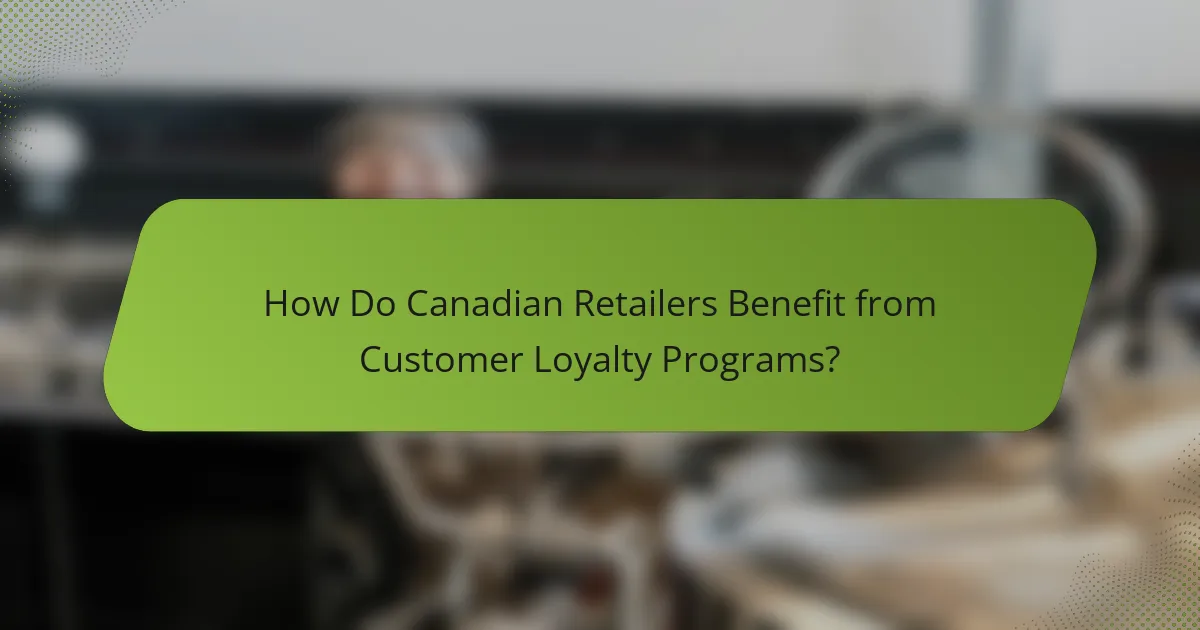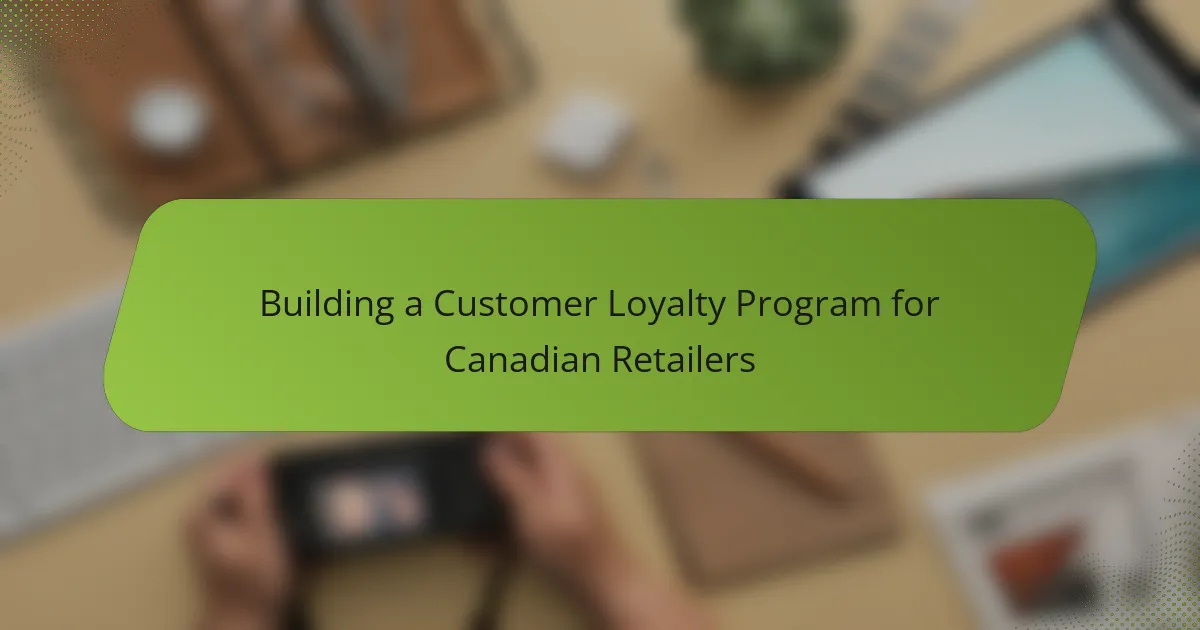Building a customer loyalty program in Canada is essential for retailers looking to boost customer retention and satisfaction. By carefully defining goals, understanding their audience, and selecting the right structure and technology, retailers can create effective programs that foster repeat purchases and deepen customer relationships.

What Are the Key Steps to Build a Customer Loyalty Program in Canada?
Building a customer loyalty program in Canada involves several key steps that ensure it meets the needs of both the retailer and the customers. By defining goals, understanding the target audience, selecting an appropriate structure, choosing the right technology, and effectively promoting the program, retailers can enhance customer retention and satisfaction.
Define program goals
The first step in creating a customer loyalty program is to clearly define its goals. Common objectives include increasing repeat purchases, enhancing customer engagement, and boosting overall sales. Setting specific, measurable goals helps in assessing the program’s success over time.
Consider aligning goals with business priorities, such as improving customer lifetime value or reducing churn rates. For example, a retailer might aim to increase repeat purchases by 20% within the first year of launching the program.
Identify target audience
Understanding the target audience is crucial for tailoring the loyalty program effectively. Retailers should analyze customer demographics, purchasing behaviors, and preferences to identify segments that would benefit most from the program. This can involve surveys, focus groups, or data analysis.
For instance, a fashion retailer might find that younger customers prefer digital rewards, while older customers value exclusive in-store offers. Segmenting the audience allows for more personalized and appealing loyalty initiatives.
Select loyalty program structure
The structure of the loyalty program can significantly impact its effectiveness. Common structures include points-based systems, tiered rewards, and cashback offers. Each structure has its own advantages and can appeal to different customer preferences.
For example, a points-based system allows customers to accumulate points for every purchase, which can be redeemed for discounts or products. Alternatively, a tiered program can encourage customers to spend more to reach higher reward levels, enhancing engagement.
Choose technology platform
Selecting the right technology platform is essential for managing the loyalty program efficiently. Retailers should look for user-friendly software that integrates seamlessly with existing systems, such as point-of-sale and e-commerce platforms. This ensures a smooth experience for both staff and customers.
Consider platforms that offer analytics capabilities to track customer behavior and program performance. Popular options in Canada include dedicated loyalty program software and customer relationship management (CRM) systems that support loyalty features.
Launch and promote program
Once the loyalty program is designed, the next step is to launch and promote it effectively. A successful launch involves clear communication of the program’s benefits to customers through various channels, such as email, social media, and in-store signage.
Consider offering an initial incentive, such as bonus points for signing up, to encourage participation. Ongoing promotion is also vital; regularly remind customers about the program through targeted marketing campaigns and highlight success stories to maintain interest and engagement.

How Do Canadian Retailers Benefit from Customer Loyalty Programs?
Canadian retailers can significantly enhance their business performance through customer loyalty programs by fostering repeat purchases and building stronger relationships with their customers. These programs not only incentivize customers to return but also provide valuable insights into consumer behavior.
Increased customer retention
Customer loyalty programs are designed to encourage repeat business, which directly contributes to increased customer retention. By rewarding customers for their purchases, retailers create a sense of value that keeps consumers coming back.
For example, offering points for every dollar spent can motivate customers to choose one retailer over another. Retailers should aim for a retention rate improvement of 5-10% through effective loyalty initiatives.
Higher average transaction value
Implementing a loyalty program can lead to higher average transaction values as customers are often encouraged to spend more to reach reward thresholds. For instance, a program that offers a discount after spending a certain amount can prompt customers to add extra items to their carts.
Retailers might see an increase in transaction value by 10-20% when customers are motivated by rewards. Setting clear, attainable goals for spending can further enhance this effect.
Enhanced customer insights
Customer loyalty programs provide retailers with valuable data on purchasing habits and preferences, enabling them to tailor their offerings. By analyzing transaction data, retailers can identify trends and adjust their inventory or marketing strategies accordingly.
For example, understanding which products are frequently purchased together can help retailers create targeted promotions. Regularly reviewing this data can lead to improved customer satisfaction and increased sales over time.

What Types of Loyalty Programs Are Effective for Canadian Retailers?
Effective loyalty programs for Canadian retailers include points-based systems, tiered rewards programs, and cashback offers. Each type has unique features that can enhance customer engagement and retention, making them valuable tools for businesses.
Points-based systems
Points-based systems reward customers with points for each purchase, which can be redeemed for discounts or free products. This straightforward approach encourages repeat purchases as customers aim to accumulate points over time.
Retailers should consider offering bonus points during promotions or for specific product categories to drive sales. For example, a retailer might offer double points on purchases made during a holiday season, incentivizing customers to buy more.
Tiered rewards programs
Tiered rewards programs create levels of membership that provide increasing benefits based on customer spending. This structure motivates customers to reach higher tiers for better rewards, such as exclusive discounts or early access to sales.
For instance, a retailer might have three tiers: Silver, Gold, and Platinum, with each tier offering progressively better perks. This can enhance customer loyalty as shoppers feel valued and recognized for their spending.
Cashback offers
Cashback offers return a percentage of the purchase price to the customer, either as cash or store credit. This type of program appeals to price-sensitive shoppers who appreciate direct financial benefits from their purchases.
Retailers can implement cashback offers on specific products or during promotional periods to boost sales. For example, offering 5% cashback on all purchases over $50 can encourage customers to spend more to receive the benefit.

What Are the Best Practices for Designing a Loyalty Program?
Effective loyalty programs are straightforward and tailored to customer preferences, enhancing engagement and retention. Key practices include ensuring simplicity, leveraging personalization, and maintaining regular communication with members.
Simplicity and clarity
A successful loyalty program should be easy to understand and navigate. Customers should quickly grasp how to earn and redeem rewards without confusion. For instance, a straightforward point system where customers earn one point per dollar spent can simplify the process.
Clear terms and conditions are essential. Avoid complex jargon and ensure that the rules for earning and using rewards are transparent. This builds trust and encourages participation.
Personalization strategies
Personalization enhances customer loyalty by making members feel valued. Use data analytics to tailor rewards based on individual shopping habits and preferences. For example, offering exclusive discounts on frequently purchased items can significantly increase engagement.
Consider segmenting your customer base to provide targeted offers. This could involve creating different tiers of loyalty based on spending levels, where higher tiers receive more personalized rewards, such as early access to sales or special events.
Regular communication with members
Consistent communication keeps your loyalty program top of mind for customers. Use email newsletters, mobile notifications, or social media to share updates on rewards, promotions, and personalized offers. Aim for a frequency that maintains interest without overwhelming members.
Encourage feedback through surveys or direct communication to understand member preferences better. This can help refine your program and ensure it meets customer expectations, ultimately fostering a stronger connection with your brand.

What Technology Solutions Support Loyalty Programs?
Technology solutions that support loyalty programs include customer relationship management (CRM) systems, loyalty program software, and mobile app integration. These tools help retailers manage customer data, track engagement, and enhance the overall customer experience.
Customer relationship management (CRM) systems
CRM systems are essential for managing customer interactions and data throughout the customer lifecycle. They allow retailers to store customer information, track purchase history, and analyze behavior to tailor loyalty offerings effectively.
When selecting a CRM, consider integration capabilities with existing systems and ease of use. Popular options in Canada include Salesforce and HubSpot, which can help streamline loyalty program management.
Loyalty program software
Loyalty program software specifically designed for managing rewards and incentives is crucial for effective customer retention. This software can automate point accumulation, redemption processes, and personalized marketing campaigns.
Look for features such as customizable rewards, analytics dashboards, and multi-channel support. Examples include Yotpo and Smile.io, which cater to various retail needs and can be tailored to fit different business models.
Mobile app integration
Integrating loyalty programs with mobile apps enhances customer engagement by providing easy access to rewards and promotions. A mobile app can facilitate real-time notifications about offers, allowing customers to redeem points conveniently while shopping.
Ensure the app is user-friendly and offers seamless navigation. Retailers should also consider incorporating features like digital wallets and location-based services to further enhance the customer experience.
